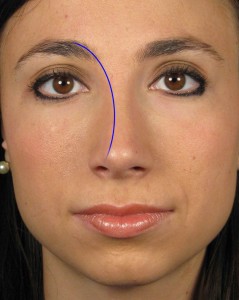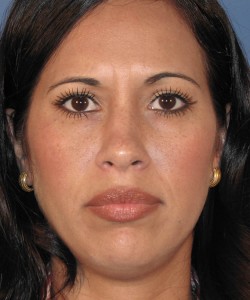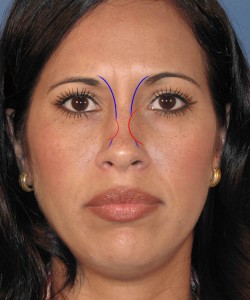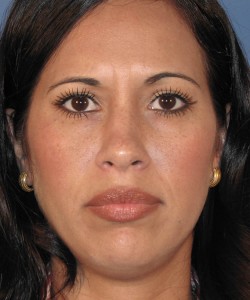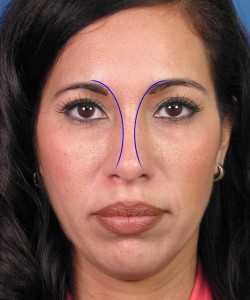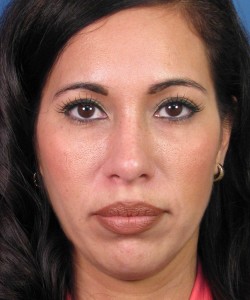Spreader grafting, or placement of spreader grafts, is a specific surgical maneuver commonly used in the world of rhinoplasty and revision rhinoplasty. The technique itself was originally introduced by famed rhinoplasty surgeon Dr. Jack Sheen sometime in the mid 1980s. At that time, Dr. Sheen proposed using spreader grafts as part of a nose reshaping procedure to reconstruct the mid-dorsum, or middle portion of the nasal bridge. Since then, the indications for use of spreader grafts in rhinoplasty and revision has expanded considerably.
Spreader Graft Placement For Nasal Function
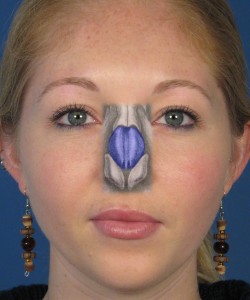
Spreader grafts are placed in the midst of a rhinoplasty or nasal reconstructive procedure for several different reasons.
The most common indication for a spreader graft is for functional problems related to the middle vault of the nose. To better understand why this is, you first have to know precisely what the middle vault refers to in rhinoplasty. The middle vault of the nose refers to the middle 1/3 of the nasal bridge. As shown in the adjacent diagram shaded in blue, the middle vault is the section of the nose above the nasal tip cartilages and below the nasal bones. To re-familiarize yourself with some of the related surface anatomy of the nose, refer back to our online rhinoplasty tutorial on nasal analysis. The middle vault is comprised of the paired upper lateral cartilages on each side and a portion of the septum running in between these two cartilage segments (called the dorsal septum). You can see this as the shaded blue area in the adjacent photo diagram. On each side of the nose, this junction of the upper lateral cartilage and dorsal septum forms an angle. We call this the internal nasal valve (or just internal valve) in the world of rhinoplasty and nasal reconstruction.
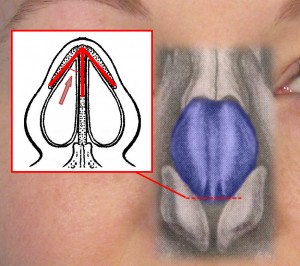
As you can see in the adjacent diagram, the internal nasal valve is that specific portion of the nose at the lower end of the middle vault. The internal nasal valve is normally between 10-15 degrees in a Caucasian nose. In ethnic noses, this angulation can be more varied. The internal nasal valve happens to be the area inside of the nose that has the highest resistance to airflow compared with any other region. Therefore, the internal nasal valve plays a vital role when it comes to nasal breathing. If this angle is less than ideal, it can dramatically increase the resistance to airflow, which translates into a higher degree of nasal obstruction. This can occur when the upper lateral cartilages are inherently weak, or more floppy than normal. It can also be seen in patients who have undergone prior rhinoplasty where the middle vault anatomy was unknowingly compromised. In the latter case, this is often not appreciated for many months to years following the original nose surgery. Patients later present with collapse of the upper lateral cartilage and feelings of difficulty breathing through their nose.
Your chosen nose expert or rhinoplasty specialist should be familiar with evaluation of the internal nasal valve. One of the most classic physical examination methods to assess the internal valve is called the Cottle maneuver. The Cottle maneuver is done while the patient breathes in gently through the nose. At the same time, the cheek is pulled out to the side, thus manually opening the internal nasal valve. A positive Cottle sign occurs when the patient subjectively senses an improvement in breathing during this maneuver. In many cases, a positive Cottle sign indicates that the patient may benefit from spreader graft placement to improve the nasal breathing.
Spreader Graft Placement For Cosmetic Appearance
The middle vault also plays a major role in terms of the cosmetic appearance of the nose. As you might imagine, in most patients the middle vault makes up the entire 1/3 of the bridge as seen on frontal view. If you remember from our rhinoplasty tutorial on nasal analysis, the front view of the nose should demonstrate two fairly equal brow-tip esthetic lines – imaginary curvilinear shadows seen when looking directly at the nose. As shown in the adjacent photo diagram of one of my own San Diego post-rhinoplasty patients, the brow-tip esthetic line starts at the eyebrow. Ideally, this gentle curve then runs along the side of the bridge, through the middle vault, before gently diverging away from the tip. If there is an abnormal contour involving the middle vault of the nose, the brow-tip esthetic line can be easily disrupted since the middle vault comprises the entire mid section of this imaginary curve. This usually involves some degree of excess narrowing, pinching, or collapse of the middle vault upper lateral cartilage. This disruption in the brow-tip esthetic line translates into abnormal shadowing when looking at the front of the nose. In some cases, there is bilateral (both sides) narrowing, pinching, or collapse of the upper lateral cartilage, while in other rhinoplasty patients there is only one side of the middle vault that is involved.
The adjacent photo example is one of my own San Diego nose reshaping patients who exemplifies this issue of middle vault narrowing. As you can see, her middle vault was causing a disruption of the brow-tip esthetic line on both sides. On her left side she was pinched inward more so than the right side. This abnormality was a result of her upper lateral cartilage being asymmetrically collapsed following rhinoplasty performed by another plastic surgeon. As a result, an abnormal and unwanted shadow is cast through the middle of her nose, making it almost look somewhat washed out through this area. Such changes can also result in a less refined and defined look to the nose.
What Does A Spreader Graft Actually Do?
So what does a spreader graft actually do in terms of nasal function and cosmetic nose appearance?
When it comes to function, the spreader graft helps to open up the internal nasal valve region we discussed earlier. If this angulation is less than the desired 10-15 degrees, it can be increased by placing a segment of cartilage between the upper lateral cartilage and dorsal septum. 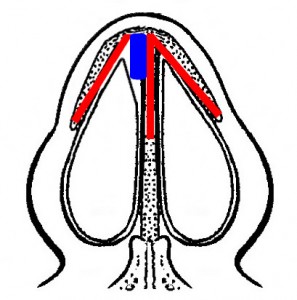 The location of the graft is indicated by the blue rectangle in the adjacent diagram and demonstrates visually how the internal nasal valve angle is opened up wider. Essentially, it spreads the middle vault and internal nasal valve wider. When it comes to resistance to airflow through this critical angle, a change of 1-2 degrees in some cases can make a significant difference. So when a spreader graft is placed correctly, this can potentially make a dramatic improvement in terms of nasal breathing.
The location of the graft is indicated by the blue rectangle in the adjacent diagram and demonstrates visually how the internal nasal valve angle is opened up wider. Essentially, it spreads the middle vault and internal nasal valve wider. When it comes to resistance to airflow through this critical angle, a change of 1-2 degrees in some cases can make a significant difference. So when a spreader graft is placed correctly, this can potentially make a dramatic improvement in terms of nasal breathing.
When it comes to cosmetic appearance, the spreader graft also helps to add volume through the middle nasal vault. As you can see in the adjacent diagram, the side with the spreader graft is now wider since placement of the graft pushes the side of the nose outward. So in rhinoplasty patients who have a depressed or collapsed upper lateral cartilage, or narrowed middle vault, a spreader graft can be used to create more width for esthetic purposes. In many cases, this helps to restore a more pleasing brow-tip esthetic line.
Like it or not, placement of a spreader graft is going to open up the internal nasal valve and technically widen the middle vault at the same time. So if your rhinoplasty specialist is recommending a spreader graft to help improve your nasal function, they should also explain that a possible byproduct of this maneuver is widening of the middle one-third of the nose when seen on frontal view. Fortunately, in many nose patients who have thicker than average skin, a relatively thin spreader graft will not add any significant width that is going to be readily visible to the naked eye. So you can improve the nasal function with a spreader graft without causing the nose to look excessively wide in patients with thick skin. In rhinoplasty patients with thin skin, they should be aware that a spreader graft will likely passively create a wider middle vault that may be noticeable following surgery.
What Is A Spreader Graft Made Of?
Spreader grafts are created by carving out a rectangular segment of cartilage. There are a variety of sources of cartilage including septum, ear, and rib. If the septum is intact, this is usually my first choice when it comes to harvesting cartilage to create a spreader graft. Ear cartilage is a reasonable alternative when there is insufficient septal cartilage remaining. It is quite rare, but some patients do need to have their rib harvesting in order to have an adequate amount of cartilage for grafting purposes.
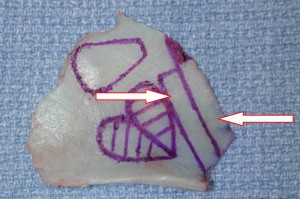 In the adjacent diagram, you can see a large segment of septal cartilage that has been removed from the inside of the nose. The white arrows point to the outline of two relatively equivalent sized and shaped pieces of cartilage. These exact pieces were intended to be the spreader grafts. Once these are carved out, they can be placed between the upper lateral cartilage and dorsal septum to open the internal valve and widen the middle vault. As you can see, septal cartilage tends to be nice and straight while also having some degree of rigidity. This holds a distinct advantage over ear cartilage when it comes to making a spreader graft. After all, the ideal spreader graft is one that is uniformly straight so that it can span the entire distance of the middle vault. In addition, it needs to be stiff enough to push the overlying cartilage and skin outward while resisting bending forces.
In the adjacent diagram, you can see a large segment of septal cartilage that has been removed from the inside of the nose. The white arrows point to the outline of two relatively equivalent sized and shaped pieces of cartilage. These exact pieces were intended to be the spreader grafts. Once these are carved out, they can be placed between the upper lateral cartilage and dorsal septum to open the internal valve and widen the middle vault. As you can see, septal cartilage tends to be nice and straight while also having some degree of rigidity. This holds a distinct advantage over ear cartilage when it comes to making a spreader graft. After all, the ideal spreader graft is one that is uniformly straight so that it can span the entire distance of the middle vault. In addition, it needs to be stiff enough to push the overlying cartilage and skin outward while resisting bending forces.
In many cases, it is necessary to layer two or more pieces of cartilage together in order to create a sufficiently robust spreader graft. Layered spreader grafts such as this are more commonly used in ethnic rhinoplasty patients with thick skin. They are also utilized in nose reshaping patients who require a more significant degree of widening of the middle vault, for instance, in those with a marked collapse of the upper lateral cartilage following a previous, overly aggressive rhinoplasty.
Spreader Graft Placement
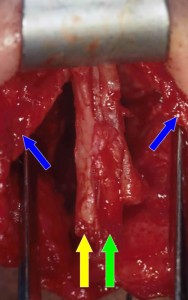 Spreader grafts can be placed using either a closed or open rhinoplasty approach. In fact, the original description by Dr. Sheen involved a closed approach to the nose. Although it is certainly possible to place a spreader graft using the closed approach, most nose specialists today prefer the open approach. The open approach means that we are making an incision under the nose in between the nostrils in order to lift the skin to expose the middle vault. As you can see in the adjacent intraoperative photo, this type of exposure is ideal when it comes to meticulous placement and suturing of the spreader grafts. In the photo, the blue arrows indicate the upper lateral cartilage on each side having been separated from the dorsal septum (green arrow). The yellow arrow is the actual spreader graft that is positioned between the upper lateral cartilage and the dorsal septum. The spreader graft is then sewn into position using fine suture threads. If bilateral spreader grafts are being placed, they are done in a very similar fashion. The upper lateral cartilage is then brought back into position and the middle vault is reconstructed with the spreader graft(s) in place. In nose reshaping patients who have thinner than average skin, your rhinoplasty specialist may recommend a temporalis fascia graft be blanketed over the middle vault after placement of the spreader graft(s). This is usually recommended to provide added cushioning of overlying skin and to prevent unwanted contour irregularities that might otherwise result.
Spreader grafts can be placed using either a closed or open rhinoplasty approach. In fact, the original description by Dr. Sheen involved a closed approach to the nose. Although it is certainly possible to place a spreader graft using the closed approach, most nose specialists today prefer the open approach. The open approach means that we are making an incision under the nose in between the nostrils in order to lift the skin to expose the middle vault. As you can see in the adjacent intraoperative photo, this type of exposure is ideal when it comes to meticulous placement and suturing of the spreader grafts. In the photo, the blue arrows indicate the upper lateral cartilage on each side having been separated from the dorsal septum (green arrow). The yellow arrow is the actual spreader graft that is positioned between the upper lateral cartilage and the dorsal septum. The spreader graft is then sewn into position using fine suture threads. If bilateral spreader grafts are being placed, they are done in a very similar fashion. The upper lateral cartilage is then brought back into position and the middle vault is reconstructed with the spreader graft(s) in place. In nose reshaping patients who have thinner than average skin, your rhinoplasty specialist may recommend a temporalis fascia graft be blanketed over the middle vault after placement of the spreader graft(s). This is usually recommended to provide added cushioning of overlying skin and to prevent unwanted contour irregularities that might otherwise result.
Spreader Graft Risks
In some patients, there may be a visible contour irregularity seen in the middle vault region after placement of a spreader graft. This can result if the spreader graft becomes displaced and rises up over the dorsal septum. Or the spreader graft can get displaced and drop inward leaving a slight depression. In other cases, the spreader grafts may result in a slightly wider bridge than desired. When done for functional reasons, some patients may not enjoy as much improvement in their nasal breathing as anticipated. Fortunately, these risks associated with spreader graft placement are somewhat unusual and fairly limited.
Spreader Graft Case Example
This is the same patient noted above who presented to my office following a prior rhinoplasty by a different plastic surgeon in San Diego. She was noting difficulty breathing through her nose on both sides. In addition, her nose did not shadow the way she desired when seen on the frontal view. As we discussed previously, she had disruption of the normal brow-tip esthetic lines that contributed to a washed out look with less than ideal definition of her nose (see left photo below). On examination of her nose inside, she was found to have evidence of narrowing of the internal nasal valve that helped explain her difficulty breathing. The upper lateral cartilages were also collapsed, which explained her abnormal shadowing in the middle of her nose. I took her to surgery and performed an open revision septorhinoplasty with placement of bilateral spreader grafts. I placed a layered graft on her left side where there was more obvious pinching of the middle vault. Postoperatively, she noted a marked improvement in her nasal breathing with a more open internal nasal valve. From a cosmetic standpoint, she also had an obvious improvement. Her nose now has fairly symmetric brow-tip esthetic lines as noted below. This translates into a more refined, defined nasal appearance as seen from the front. To learn more about spreader grafts and rhinoplasty, feel free to visit my online Emedicine chapter – Plastic Surgery, Nose, Rhinoplasty, Spreader Grafts.

